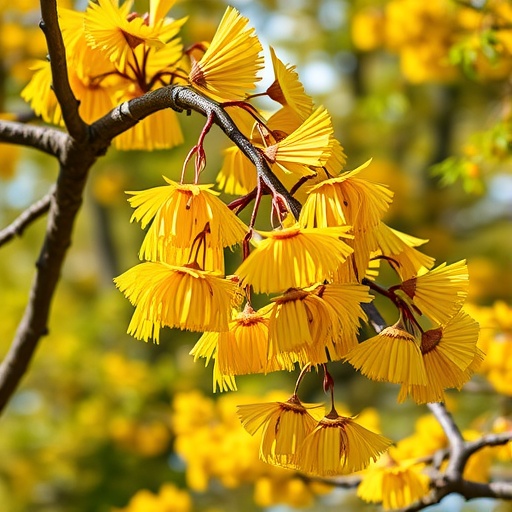In an unprecedented investigation into the rejuvenation processes of the ancient Ginkgo biloba, researchers have unveiled groundbreaking insights into the physiological and molecular mechanisms governing flavonoid and hormone biosynthesis. The study, spearheaded by a team led by Li, F., Zhang, T., and Wan, R., provides a thorough exploration of how the oldest ginkgo tree, thought to possess remarkable longevity traits, can return to a state of youthful vigor. This research can potentially reshape our understanding of plant longevity and regeneration.
The Ginkgo biloba, often hailed as a “living fossil,” has fascinated botanists and geneticists alike, not merely due to its incredible age but also for its unique biochemical properties. The findings of this study elucidate the interplay between flavonoids—natural compounds with protective roles—and plant hormones, both of which are crucial for maintaining cellular health and regulating growth. The exploration of these compounds provides vital clues in the quest to unravel the secrets behind ginkgo’s exceptional resilience and longevity.
The research begins with a detailed examination of the plant’s unique flavonoid composition. Flavonoids are not just responsible for the vibrant colors in plants but also play intricate roles in UV filtration, pathogen defense, and even pollen attraction. In this study, scientists identified specific flavonoid pathways that appeared to be significantly activated in rejuvenated ginkgo tissues. This activation prompts a fascinating discussion about the potential evolutionary advantages conferred by these compounds and their enhancement in response to environmental stressors.
Furthermore, the team utilized advanced genomic technologies and high-throughput sequencing to dissect the genetic underpinnings of these biosynthetic pathways. The identification of key regulatory genes provides a compelling narrative of how the ginkgo tree orchestrates its response to external stimuli, contributing to its rejuvenation. These profound insights not only illuminate the biological intricacies of Ginkgo biloba but also pave the way for potential biotechnological applications.
A critical aspect of the research was the examination of the hormonal interplay involved in the rejuvenation process. Auxins, gibberellins, and cytokinins—key plant growth regulators—were found to be intricately linked to both flavonoid biosynthesis and the overall health of the ginkgo tree. The study discusses how changes in hormonal signaling can lead to shifts in flavonoid production, affecting vital physiological processes. This can be seen as a systematic adaptation mechanism—allowing the plant to navigate through environmental shifts while maintaining its remarkable longevity.
Moreover, the study utilized metabolomic analysis to correlate heightened levels of flavonoids and hormones with physiological responses such as increased vigor and enhanced stress tolerance. This comprehensive approach underscores the multidimensional nature of plant adjustments to their environment. The implications of this are manifold, suggesting not only avenues for enhancing crop resilience but also contributing to our understanding of plant longevity in an era of climate change.
Interestingly, the phenomenon of rejuvenation observed in the ginkgo tree has sparked curiosity regarding its application in other long-lived species. Could these findings be translatable to other ancient organisms? The research opens up a potentially fruitful line of inquiry, urging scientists to explore if similar mechanisms are at play in other centenarian plants. This leads to questions about the evolutionary significance behind these sophisticated metabolic pathways and whether they offer clues related to survival and adaptation.
The results of Li et al. also raise pertinent questions about the future of botanical research. With plant extinction rates rising and biodiversity facing unprecedented threats, understanding resilience at a molecular level could be vital. Would advancing our grasp on such mechanisms allow us to bolster the survival of endangered species? The ongoing exploration of the rejuvenated ginkgo tree hints that the answers may lie deeper in nature’s playbook, waiting to be unveiled.
Furthermore, the environmental significance of flavonoids goes beyond mere tree anatomy; they also play a role in atmospheric chemistry. The ability of such biochemical compounds to mitigate oxidative stress not only benefits the plant but, in turn, contributes to a healthier ecosystem. The findings suggest that nurturing the biosynthetic pathways responsible for flavonoid production could enhance urban forestry practices, linking back to improving urban air quality.
Overall, the multidisciplinary nature of this study—encompassing genomics, plant physiology, and environmental science—underscores the need for a cohesive framework for understanding plant biology. It serves as a call to action for researchers and policymakers alike, emphasizing the importance of scientific inquiry into plant longevity as a fundamental Packer of solving global challenges.
The research demonstrates not just a scientific endeavor but a passionate drive to deepen our understanding of life and its persistence. The revelations about the Ginkgo biloba’s regenerative abilities challenge us to rethink our approaches to conservation and agricultural practices. As knowledge accumulates, it leads us to ponder a future where ancient wisdom and modern science harmoniously coexist.
In conclusion, the discoveries relating to the rejuvenated Ginkgo biloba are not merely an academic curiosity; they hold significant potential to influence the fields of horticulture, biotechnology, and environmental conservation. They remind us of the intricate web of life, of how we are connected to the oldest living species on the planet, and of our shared journey in the pursuit of knowledge that could ensure the survival of countless species in the face of rapidly changing environmental conditions.
As this groundbreaking research circulates through scientific circles and beyond, it reinforces the notion that the most resilient parts of nature often have lessons to impart—lessons not just for plants, but for humanity itself.
Subject of Research: Mechanisms of flavonoid and hormone biosynthesis in Ginkgo biloba
Article Title: Physiological and molecular regulatory mechanisms of flavonoid and hormone biosynthesis in rejuvenated the oldest ginkgo tree
Article References:
Li, F., Zhang, T., Wan, R. et al. Physiological and molecular regulatory mechanisms of flavonoid and hormone biosynthesis in rejuvenated the oldest ginkgo tree.
BMC Genomics 26, 773 (2025). https://doi.org/10.1186/s12864-025-11935-w
Image Credits: AI Generated
DOI: 10.1186/s12864-025-11935-w
Keywords: Ginkgo biloba, flavonoids, hormone biosynthesis, longevity, rejuvenation, environmental adaptation, genetic pathways, plant resilience




